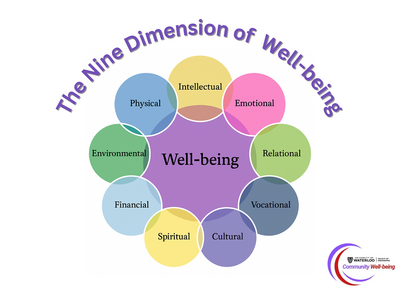The Nine Dimensions of Well-being
Wellness and well-being mean different things to different people. In fact, if you ask people to define wellness you will probably receive a variety of answers. The World Health Organization defines health as:
A state of complete physical, mental and social well-being and not merely the absence of disease or infirmity

Well-being is a dynamic concept created to ascertain the conditions that allow humans to flourish. Well-being goes beyond physical health to include an individual’s ability to identify and achieve goals, satisfy needs, and the ability to change and cope with the demands of our environment. Well-being is a connection point encompassing many elements that we refer to as “Dimensions of Well-being”.
While there are many models of well-being such as the balance, and empty tank models, the Community Well-being Team chose a dimensional model to guide programming to support well-being. Dimensional models recognize that humans are interconnections of several aspects. These aspects influence each other, and can support or diminish other aspects of well-being.
One of the earliest dimensional models for well-being was the medicine wheel emphasized by many indigenous cultures. The medicine wheel focuses on the balance between four states of being: physical, spiritual, emotional, and mental. As part of our commitment to truth and reconciliation, the Community Well-being Team would like to acknowledge the important role the medicine wheel plays as the foundational concept that led to development of the dimensional models that would follow later. The four states of being of the medicine wheel, can be seen in the 9-dimesions of well-being module utilized by the Faculty of Engineering.
In 1976, Dr. Bill Hettler, co-founder of the National Wellness Institute, published his six dimensions of wellness which added the occupational and social dimensions to the four states of the medicine wheel. The publication of Hettler's dimensions sparked academic and public health interest in applying this approach to improve well-being. The premise of his model was that well-being is the sum of many interconnected dimensions that work together to create a holistic sense of well-being and fulfillment in a person’s life.
Since Hettler published his model in 1976, dimensional models have continued to expand and develop with many versions available. The nine dimensions the University of Waterloo, Faculty of Engineering Community Well-being program focuses on are as follows:
Please note that clicking on one of the dimensions below will open the corresponding webpage, where you will find a definition of the dimension and a variety of resources both on campus as well as off campus.
Well-being can be seen as a balancing act between the demands and challenges from our environment and our resources, or capacity, to deal with those challenges.

Interested in Knowing More About Well-being?
Looking to enhance your knowledge about well-being? Below are some resources both on and off campus, as well as general information related to wellbeing.
*Please note: Any resources displayed on this page are not comprehensive and do not indicate an endorsement by the ENGWellness Program. You should always do your own research before using any resource. By accessing any of the resources on this page, you understand that the ENGWellness Program is not liable for any actions or the actions of representatives or services on this list. The listed resources, while helpful, are not a replacement for professional support.
Acknowledgement and Usage Permsions
The Faculty of Engineering would like to acknowledge Sam Vandekerckhove and Renate Donnovan. In 2018, Sam and Renate adapted Dr. Bill Hettler's 6-Dimentions of Wellness model to create a 9-Dimensions of Wellness model that reflected the needs and demands of the MME and ECE engineering programs. Since the creation of the ENGWellness 9-Dimensions of Wellness, the model has been further refined and updated. The 9-Dimensions of Well-being are now the cornerstone of the FoE Community Well-being Strategy and utilized in the creation of well-being initiatives across the entire Faculty of Engineering. The model has also been adopted by other areas at the University of Waterloo and beyond. Sam and Renate, what a great legacy!
Those interested in sharing the information on the 9 - Dimensions of Well-being currently used by the Faculty of Engineering, are welcome to link to our website. Any usage of the content beyond linking to our website, requires additional permissions.